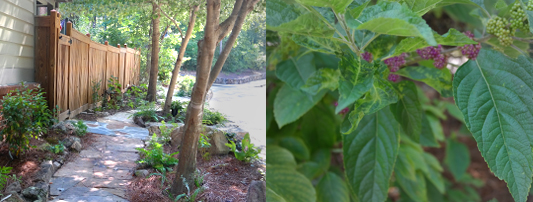
Growing Native Plants with Mt Laurel Resident Bill Hunter
Bill Hunter knows a thing or two about growing native plants. His yard boasts a resplendent variety of indigenous perennials that neighbors frequently stop by to admire. “It’s been a forum for meeting people—a way to talk about what other residents want to do in their yards,” said Hunter. Bill and his wife Lynda moved to Mt Laurel in early May of this year, and quickly began transforming their yard into a gorgeous oasis of greenery. An avid outdoorsmen and horticulturalist, Hunter’s two eldest sons now operate the tree nursery Hunter Trees, LLC, that they started together more than 10 years ago. And his love for “making things grow” hasn’t relinquished its hold. Now retired, he spends his days sharing his knowledge with Mt Laurel residents—and any one of the numerous people that stop by his yard.
Knowing what plants need to grow (sun/shade, moisture levels, soil acidity, etc.) is critical to their success—an understanding that informs the organization of Hunter’s yard. In areas that receive abundant sunlight, coneflowers, bottlebrush buckeye, Shasta daisies, coreopsis, stonecrop, blue star, Indian physic, swamp hibiscus, and a wide variety of other native plants grow. The swamp hibiscus—a bog plant that thrives in damp soil—produces a beautiful red blossom and can reach heights of 6’ to 7’ feet. Hunter used plastic lining to create a basin for the plant, surrounding it with leaf compost to keep the area sufficiently fertile. Exquisite oakleaf hydrangeas, beautyberries, and dogwoods, often seen in residents’ lawns, steadily mature in multiple spots. In more shaded areas, a wide variety of ferns flourish, with species including log fern, ebony spleenwort, cinnamon fern, royal fern, broad beech fern, and Christmas fern—an evergreen that maintains its verdant shade throughout the winter months. “There’s about 15-20 ferns on the native plant list, and I have about a dozen of them in my yard,” said Hunter. Even with as many plants listed above, this catalog hardly does Hunter’s work justice. Simply stroll by the Nolen Street home, and you’ll be amazed by the diversity of vegetation present.
Hunter’s passion for indigenous plants, however, extends far beyond their stunning appearance. “The great thing about native plants is that they’re used to being out here taking care of themselves without the aid of man. In times of drought and when the roots are first starting to take hold, they require watering, but otherwise, these plants are accustomed to this soil and the climate,” he said. Hunter recognizes the delicate balance of the ecosystem established in his yard, noting that certain plants, such as the Clethra, provide the optimal spot for butterflies to attach their larva. “Some insects, butterflies, and animals only exist in concert with native plants, so taking away those plants means taking away those creatures,” Hunter adds. His dedication to the conservation of native species echoes Mt Laurel’s respect for nature and commitment to building a community nestled within nature, not imposed upon it.
After living in Dunnavant Place for several years, the Hunter’s decided that the nearby town of Mt Laurel was their dream location. “Almost every day, I would bring Louie [the couple’s yellow lab; (they also own a Havenese named Pocco)] to walk around the park in Mt Laurel. I saw how beautiful it was and met so many great people on our walks; everyone thought we were already living here. The natural habitat, the people, and this beautiful home—that’s what really drove our decision to move here,” Hunter said. Since then, Bill and Lynda have become involved in the community, joining groups including the Mt Laurel Garden Club, Book Club, and Sipping Seniors. “We enjoy meeting people with common interests; it’s being part of something—a community—that makes living here such an enchanting experience.”
Sign up for the Mt Laurel newsletter to receive more community and events-related news.





